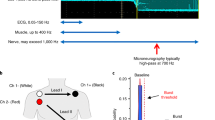Abstract
To investigate a broader spectrum of responses to the activity of efferent sympathetic nerve endings in blood vessels and sweat glands of the human palmar skin, we have developed a method to measure skin potential, skin unipolar electrical admittance (conductance and capacitance), skin blood flow, and skin temperature simultaneously at the same site of human palmar skin. The electrical variables were measured with a specially designed probe and a three electrode lock-in amplifier measuring system. The aim of the paper is to evaluate this method and its potential application in clinical work. The experimental results from five subjects during 5 min of baseline condition and during repeated acoustic stimulation are presented. The skin temperature was displayed digitally. During basal condition the activities in skin electrical variables and in blood vessel vasomotion were largely independent (asynchronous), whereas efferent sympathetic discharges due to stimulation were followed by parallel evoked responses in skin admittance, skin potential and skin blood flow. Habituation to the repeated stimuli occurred differently in the four variables.
Similar content being viewed by others
Abbreviations
- A :
-
amplification of open-loop operational amplifier
- c :
-
subscript referring to current-carrying electrode
- C :
-
skin electrical capacitance
- CNS:
-
central nervous system
- E:
-
electrode
- EDA:
-
electrodermal activity
- f :
-
frequency
- F :
-
skin blood flux value
- G :
-
skin electrical conductance
- i :
-
current
- j :
-
√−1
- m :
-
subscript referring to measuring electrode
- OA:
-
operational amplifier
- P :
-
skin potential
- r :
-
subscript referring to electrical reference electrode
- Rs :
-
shunt resistor
- SBF:
-
skin blood flow
- t :
-
time
- T :
-
skin temperature
- U :
-
endosomatic skin potential
- U ex :
-
excitation voltage
- V :
-
potential difference betweenE m andE c
- Y :
-
skin electrical admittance
- Z :
-
skin electrical impedance
- Z mc :
-
deep tissue segmental impedance
- Δ:
-
event-related response
- ω:
-
2πf
References
Beatty, J. (1986) Neuromagnetic analysis of human cognitive processing. 3rd Int. Evoked Potential Symp. West Berlin.
Darrow, C. W. (1937) Neural mechanisms controlling the palmar galvanic skin reflex and palmar sweating.Arch. Neurol. Psychiatry,37, 641–663.
Edelberg, R. (1967) Electrical properties of the skin. InMethods in psychophysiology.Brown, C. (Ed.), Williams & Wilkins, Baltimore, 16.
Geddes, L. A. (1972)Electrode and measurement of bioelectric events. Wiley-Interscience, New York 55–59.
Goodall, McC. (1970) Innervation and inhibition of the eccrine and apocrine sweating in man.J. Clin. Pharmacol.,10, 235–246.
Grimnes, S. andQiao, Z.-G. (1985) Electrical measurements, ionic permeability of the skin. Int. Symp. Skin Care and Function, Oslo.
Moruzzi, G. andMagoun, H. W. (1949) Brain stem reticular formation and activation of the EEG.EEG & Clin. Neurophysiol.,1, 455–475.
Mørkrid, L., Ohm, O.-J. andHammer, E. (1980) Signal source impedance of implanted pacemaker electrodes estimated from the spectral ratio between loaded and unloaded electrograms in man.Med. & Biol. Eng. & Comput.,18, 223–232.
Mørkrid, L., Qiao, Z.-G., andReichelt, K. L. (1987) Effect of methylphenidate on skin conductance in hyperactive children and its relationship to urinary peptides.J. Oslo City Hospitals,37, 35–40.
Qiao, Z.-G., Mørkrid, L. andGrimnes, S. (1987) Simultaneous measurement of electrical admittance, blood flow and temperature at the same skin site with a specially designed probe.Med. & Biol. Eng. & Comput.,25, 299–304.
Richter, C. P. (1929) Physiological factors involved in the electrical resistance of the skin.Am. J. Physiol.,88, 596–615.
Salerud, E. G. andNilsson, G. E. (1986) Integrating probe for tissue laser Doppler flowmeters.Med. & Bio. Eng. & Comput.,24, 415–419.
Thoresen, M. andWalloe, L. (1980) Skin blood flow in humans as a function of environmental temperature measured by ultrasound.Acta. Physiol. Scand.,109, 331–341.
Venables, P. H. andChristie, M. J. (1980) Electrodermal activity. InTechniques in psychophysiology.Martin, I. andVenables, P. H. (Eds.), John Wiley & Sons, 7–45.
Wang, G. H. (1957) The galvanic skin reflex. A review of old and recent works from a physiological point of view. Part I.J. Physical Med.,36, 295–320.
Wang, G. H. (1958) The galvanic skin reflex. A review of old and recent works from a physiological point of view. Part II. ——Ibid.,,37, 35–37.
Author information
Authors and Affiliations
Rights and permissions
About this article
Cite this article
Qiao, Z.G., Morkrid, L. & Grimnes, S. Three-electrode method to study event-related responses in skin electrical potential, admittance and blood flow. Med. Biol. Eng. Comput. 25, 567–572 (1987). https://doi.org/10.1007/BF02441751
Received:
Accepted:
Issue Date:
DOI: https://doi.org/10.1007/BF02441751




